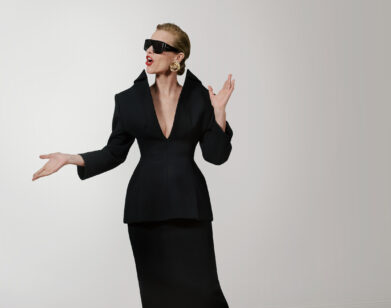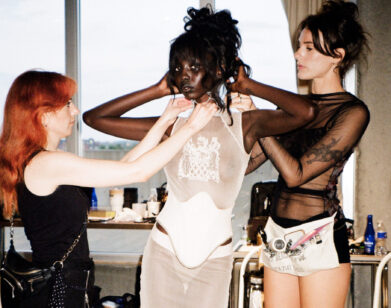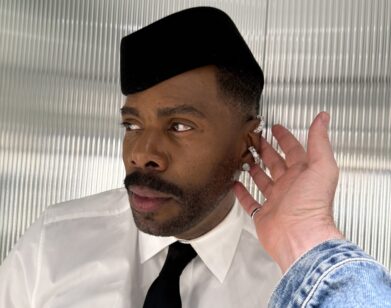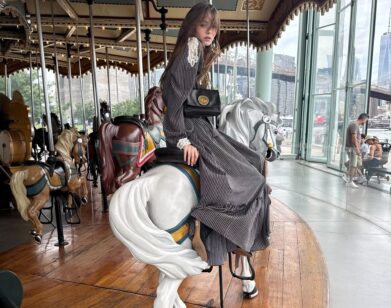The Campana Brothers Save Lacoste’s Skin
It all began four years ago, when Philippe Lacoste bought the Campana Brothers’ Alligator chair, a stuffed animal pile-up of poison green toy alligators for a lounge chair that’s become one of the Brazilian salvage design duos classics. “We thought it was amazing and that perhaps Lacoste would furnish its headquarters with them and buy a lot,” says Fernando Campana. “Two years later we were contacted by our colleague, the designer Michael Young, and we began our collaboration on the Lacoste polo.”
This is the French polo maker’s fourth holiday design collaboration, and it’s one of the most amusing. It’s also one of the most prestigious, as the Campanas are Latin America’s foremost design stars.
For Lacoste’s women’s super limited edition (12 shirts will be produced) the Campanas turned the alligator logo into lace, inspired by Northern Brazil’s lacemaking tradition, using 3000 of the little critters painstakingly hand sewn into a polo by seamstresses of the Coopa-Roca cooperative located in the Rocinha favela, Rio’s largest slum with an estimated population of nearly 180,000 people. (LEFT: ALLIGATOR CHAIR. COURTESY OF VITRA)
The shirt is truly tennis haute couture; each seamstress makes about 30 alligator’s worth of lace per day, so one polo represents 100 days’ labor. The Campanas did four styles, ranging from a simple eight-Alligator chest cluster to a more exclusive edition for men with the alligators teaming up in the shape of the Amazon’s Anavilhanas fluvial islands, and another for women featuring a rumba line of alligators mimicking Lianas, the vines of which grow on the trees in the tropical rainforest.
“This is really our childhood,” says Fernando, “we grew up in the countryside wearing Lacoste polos. We were raised near the Jacaré river which means crocodile in Portuguese. And instead of asking if we wanted a polo, our parents would say: ‘do you want a Jacaré? ‘”
The Campana’s typical field of operations is the streets. They’re inspired by Brazil’s make do culture and carnival spirit and in their hands wood scraps, rubber hosing, fabric cast offs, old bottles and antennas become elegant, whimsical and thought-provoking chairs, tables and lighting.
Meanwhile, currently at Vitra in Berlin is “ANTIBODIES The Works of Fernando & Humberto Campana 1989 – 2009,” a retrospective of the brothers’ two decade collaboration which runs through February 28, 2010 and will travel for five years. “For us Lacoste is synonymous with its logo and because our work is about reprocessing existing elements it was natural to give a new reading to the alligator,” says Humberto.
Lacoste agrees. It’s become the first brand to work with Save Your Logo, a new organization to protect endangered species and biodiversity. In this case that means crocodiles, alligators, caimans, gavials, and their habitat. To celebrate the organization and its Campanas collaboration, Lacoste turned Paris’s freshly created Ministry of Ecology, Energy and Durable Development, headquartered in the lush Hotel de Roquelaure on the Blvd Saint Germain, into a mini amazon, covering the hotel’s parquet with a carpet of green grass and filling the rooms with a garden of tropical flowers and trees.
This isn’t the first time the Campanas have designed for the body, recent collaborations include plastic shoes for Brazilian giant Melissa and jewelry for H. Stern. We’re into everything that has to do with handcraft,” says Humberto. Today design is completely linked whether it’s fashion, architecture, gardening or film, the only things you need to create in any field today are curiosity and Freedom”
The Campanas current project is the reconstruction of Athens’ old Olympic Palace Hotel. Designed in 1958 by Iasona Rizos and considered a prime example of 60s modern design, it’s the pet project of Greek mogul and art collector Dakis Ioannou and has been rebaptized Yes. “This is the Scarface of architecture,” says Humberto. “We’re taking the hotel apart piece by piece and reassembling it without discarding anything.” The Campanas have created a workshop on site where they spend about two weeks each month with a team of Greek design students to transform everything from the hotel’s chandeliers to diningroom chairs into new design. After two years work, Yes should open early next year.






